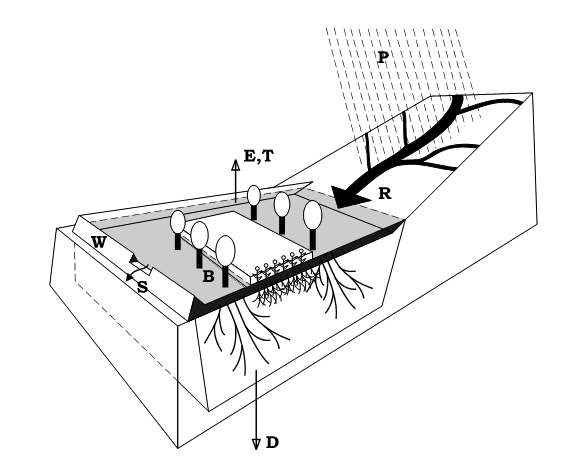Runoff water for Agroforestry
The major difficulty in developing desert agroforestry is low rainfall. Because of the major imbalance between local precipitation and the water required to support both crops and trees, artificial irrigation would normally be required. However, piping in water from a more humid area for both crops and trees is uneconomical. To solve this problem, the BIDR researchers turn to an extremely ancient approach for arid-zone farming, runoff irrigation, in which sudden downpours of desert rain falling over a large watershed abutting the cultivated area are trapped by dams-surrounding the agricultural plots. The application of runoff irrigation to support arid-region agroforestry is a novel concept in the field.

Fig. 1. Scehematic presentation of an agroforestry sysystem under runoff conditions. Precipitation (P) generates surface runoff (R) on hill slopes, which accumulates into natural tributaries feeding a level runoff basin (B). The collected runoff water is trapped by a retaining wall (W) allowing the water to percolate into the soil profile (D). The stored water is transpired (T) by deep rooting trees and shallow rooting annuals, while looses by evaporation (E) and deep percolation are minimized. The built-in spillway (s) controls surplus water.
In order to design an economically viable desert agroforestry system, the complex interactions between the various plant species and environmental variables must be clarified. The BIDR investigators monitor shoot development of the annual intercrop, tree-root development, microclimatic factors and water-balance figures in experimental runoff agroforestry fields. By studying interactions among these factors as tree and intercrop densities are varied, they found that runoff agroforestry – without supplementary irrigation – enabled the production of grains, fodder, and firewood in areas with annual precipitation as low as 100-300 mm. These findings have far reaching consequences for the sustainable economic advance of arid-zone populations.
Previous section Next section